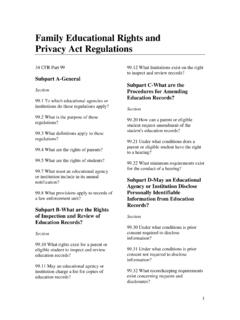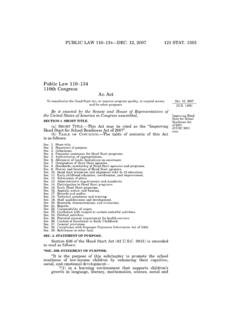Transcription of Guidance on Recontributions, Rollovers and Qualified ...
1 Guidance on Recontributions, Rollovers and Qualified higher education Expenses under Section 529. Notice 2018-58. I. PURPOSE AND OVERVIEW. This notice announces that the Department of the Treasury (the Treasury Department). and the Internal Revenue Service (the IRS) intend to issue regulations providing clarification regarding (1) the special rules for contributions of refunded Qualified higher education expenses to a Qualified tuition program under 529(c)(3)(D) of the Internal Revenue Code (Code); (2) the new rules under 529(c)(3)(C)(i)(III) permitting a rollover from a Qualified tuition program to an ABLE account under 529A; and (3) the new rules under 529(c)(7) treating certain elementary or secondary school expenses as Qualified higher education expenses. II. BACKGROUND. Under 529, a State or its agency or instrumentality may establish or maintain a program that permits a person to prepay or contribute to an account for a designated beneficiary's Qualified higher education expenses (QHEEs).
2 In addition, an eligible educational institution may establish or maintain a program that permits a person to prepay a designated beneficiary's QHEEs. These programs are collectively referred to as section 529 Qualified tuition programs (QTPs). Section 529(c)(3) provides that distributions (including any attributable earnings) from a QTP are not included in gross income if such distributions do not exceed the designated beneficiary's QHEEs. To the extent distributions exceed the designated beneficiary's QHEEs, a portion of the distribution is included in gross income. Prior to its amendment by An Act to provide for reconciliation pursuant to titles II and V. of the concurrent resolution on the budget for fiscal year 2018 , 115-97 (the 2017 Act ), signed into law on December 22, 2017, 529(e)(3)(A) defined QHEEs to include tuition, fees, books, supplies, and equipment required for the enrollment or attendance of a designated beneficiary at an eligible educational institution, 1 including certain computer equipment and software used primarily by the beneficiary during any years the beneficiary is enrolled at an eligible educational institution.
3 In the case of a special needs beneficiary, QHEEs include expenses for special needs services that are incurred in connection with such enrollment or attendance. QHEEs also include reasonable costs for room and board for eligible students as defined in 25A(b)(3) (generally, those who are enrolled at least half-time). Sections 529(c)(3)(C)(i)(I) and (II) permit a tax-free rollover of a distribution from a QTP, made within 60 days of the distribution, to another QTP for the benefit of either the same designated beneficiary or another designated beneficiary who is a member of the family of the original designated beneficiary. However, Notice 2001-81, 2001-52 617, provides that the distributing QTP must provide a breakdown of the earnings portion of the rollover amount to the recipient QTP and, until the recipient QTP receives appropriate documentation showing the earnings portion, the entire rollover amount is treated as earnings.
4 Notice 2001-81 applies the same rule to a direct transfer ( , a trustee-to-trustee transfer) from a QTP to another QTP. Section 529(c)(3)(D), added to the Code by the Protecting Americans from Tax Hikes Act of 2015 (PATH Act), part of the Consolidated Appropriations Act, 2016 (Pub. L. 114-113), addresses situations in which QTP funds are distributed for a beneficiary's QHEEs, but some 1. Section 529(e)(5) defines an eligible educational institution as an institution (A) which is described in 481 of the higher education Act of 1965 (20 1088), as in effect on the date of the enactment of this paragraph, and (B) which is eligible to participate in a program under title IV of such Act. 2. portion of those expenses is refunded to the beneficiary by the eligible educational institution. This could occur, for example, if the beneficiary were to drop a class mid-semester.
5 Section 529(c)(3)(D) provides that the portion of such a distribution refunded to an individual who is the beneficiary of a QTP by an eligible educational institution is not subject to income tax to the extent that the refund is recontributed to a QTP of which that individual is the beneficiary not later than 60 days after the date of such refund and does not exceed the refunded amount. Section 529(c)(3)(D) applies to refunds received after December 31, 2014. The PATH Act also included a transition rule with regard to the deadline for recontributing a refund received after 2014 but before the date of enactment (December 18, 2015). Specifically, those refunded distributions are exempt from income tax if they were recontributed to the beneficiary's QTP not later than February 16, 2016 (60 days after the date of enactment of the PATH Act).
6 The 2017 Act added 529(c)(3)(C)(i)(III) which provides that a distribution from a QTP. made after December 22, 2017, and before January 1, 2026, is not subject to income tax if, within 60 days of the distribution, it is transferred to an ABLE account (as defined in 529A(e)(6)) 2 of the designated beneficiary or a member of the family of the designated beneficiary. Under 529(c)(3)(C)(i), the amount of any rollover to an ABLE account is limited to the amount that, when added to all other contributions made to the ABLE account for the taxable year, does not exceed the contribution limit for the ABLE account under 529A(b)(2)(B)(i), , the annual gift tax exclusion amount under 2503(b). In addition, the 2017 Act expanded the definition of QHEEs to include tuition in connection with the designated beneficiary's enrollment or attendance at an elementary or secondary public, private, or religious school.
7 See 529(c)(7). The 2017 Act also amended 2. Generally, an ABLE account is established under a 529A Qualified ABLE program to pay the Qualified disability expenses of an eligible individual who is blind or has a disability. 3. 529(e)(3)(A) to limit the total amount of these tuition distributions for each designated beneficiary to $10,000 per year from all QTPs of the designated beneficiary. Both amendments apply to distributions made after December 31, 2017. III. RECONTRIBUTION OF REFUNDED QHEEs The Treasury Department and the IRS are aware of concerns expressed by QTP. administrators regarding the administrative burdens that would arise if a recontribution of a refunded QHEE is treated in the same manner as a rollover under Notice 2001-81 requiring a breakdown of the earnings portion of the recontribution.
8 Because the amount is refunded by the eligible educational institution, which will have no information regarding the income portion of each tuition payment (whether made from a single or multiple QTPs), QTP administrators generally would be unable to determine the earnings portion of the recontribution. Accordingly, the Treasury Department and the IRS intend to issue regulations providing that the entire recontributed amount will be treated as principal. This rule of administrative convenience will eliminate the burdens associated with determining the earnings portion. Furthermore, because the recontributed amount previously was taken into account in applying the overall contribution limit under 529(b)(6), the Treasury Department and the IRS anticipate that the regulations will provide that the recontributed amount does not count against the limit on contributions on behalf of the designated beneficiary under 529(b)(6).
9 In addition, consistent with 529(c)(3)(D), the Treasury Department and the IRS anticipate that the regulations will confirm that the recontribution must be to a QTP for the benefit of the designated beneficiary who received the refund of QHEEs, although the recontribution need not be to the QTP from which the distributions for the QHEEs were made. IV. ROLLOVER FROM A QTP TO AN ABLE ACCOUNT. 4. In accordance with new 529(c)(3)(C)(i)(III), the Treasury Department and the IRS. intend to issue regulations providing that a distribution from a QTP made after December 22, 2017, and before January 1, 2026, to the ABLE account of the designated beneficiary of that QTP, or of a member of the family of that designated beneficiary, is not subject to income tax if two requirements are satisfied. First, the distributed funds must be contributed to the ABLE.
10 Account within 60 days after their withdrawal from the QTP. Second, the distribution, when added to all other contributions made to the ABLE account for the taxable year that are subject to the limitation under 529A(b)(2)(B)(i) (the annual gift tax exclusion under 2503(b)), must not exceed that limitation. Specifically, the regulations are expected to provide that the sum of the distribution and all other contributions to the ABLE account for the taxable year, other than contributions of the designated beneficiary's compensation as described in 529A(b)(2)(B)(ii), must not exceed the annual gift tax exclusion for that taxable year. Consistent with the longstanding approach of treating direct transfers similarly to Rollovers in Notice 2001-81, the Treasury Department and the IRS also anticipate that the regulations will provide that the same rules will apply regardless of whether such a QTP distribution is rolled over to an ABLE account or instead is transferred by a direct transfer from a QTP to an ABLE account.











